Important Questions for Class 12 Physics Chapter 13 Nuclei Class 12 Important Questions
Nuclei Class 12 Important Questions Very Short Answer Type
Question 1.
An electron and alpha particle have the same de-Broglie wavelength associated with them. How are their kinetic energies related to each other?
(Delhi 2008)
Answer:
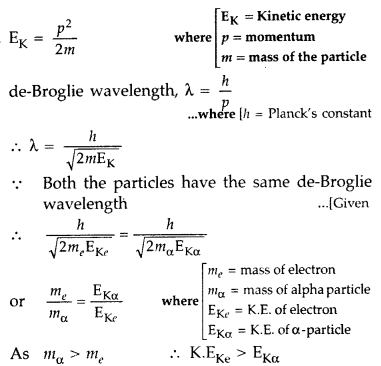
Question 2.
State the reason, why heavy water is generally used as a moderator in a nuclear reactor. (Delhi 2008)
Answer:
Neutrons produced during fission get slowed if they collide with a nucleus of the same mass. As ordinary water contains hydrogen atoms (of mass nearly that of neutrons), so it can be used as a moderator. But it absorbs neutrons at a fast rate via reaction :
![]()
Here d is deutron. To overcome this difficulty, heavy water is used as a moderator which has negligible cross-section for neutron absorption.
Question 3.
Name the absorbing material used to control the reaction rate of neutrons in a nuclear reactor. (Delhi 2008)
Answer:
Control rod or cadmium rod.
Question 4.
State tzvo characteristic properties of nuclear force. (All India 2008)
Answer:
(i) Nuclear forces are the strongest force in nature.
(ii) They are saturated forces.
(iii) They are charge independent.
Question 5.
Two nuclei have mass numbers in the ratio 1: 2. What is the ratio of their nuclear densities? (Delhi 2009)
Answer:
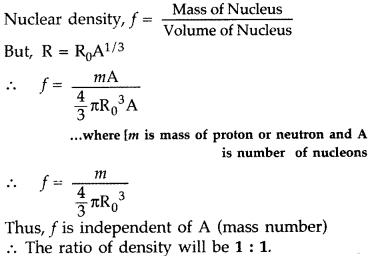
Question 6.
Two nuclei have mass number in the ratio 1 : 3. What is the ratio of their nuclear densities? (Delhi 2009)
Answer:
Since nuclear density is independent of the mass number, the ratio of nuclear densities will be 1:1.
Question 7.
Two nuclei have mass numbers in the ratio 2 : 5. What is the ratio of their nuclear densities? (Delhi 2009)
Answer:
Nuclear density is independent of mass number, so the ratio will be 1 : 1.
Question 8.
Two nuclei have mass numbers in the ratio 1: 8. What is the ratio of their nuclear radii? (All India 2009)
Answer:

Question 9.
Two nuclei have mass numbers in the ratio 8:125. What is the ratio of their nuclear radii? (All India 2009)
Answer:

Question 10.
Two nuclei have mass numbers in the ratio 27:125. What is the ratio of their nuclear radii? (All India 2009)
Answer:

Question 11.
Write any two characteristic properties of nuclear force. (All India 2009)
Answer:
1. Nuclear forces are strongest forces in nature.
2. Nuclear forces are charge independent.
Question 12.
What is the relationship between decay constant and mean life of a radioactive nucleus? (Comptt All India 2009)
Nuclei Class 12 Important Questions Very Short Answer Type VSA-I
Question 1.
An electron and alpha particle have the same de- Broglie wavelength associated with them. How are their kinetic energies related to each other? (Delhi 2008)
Answer:
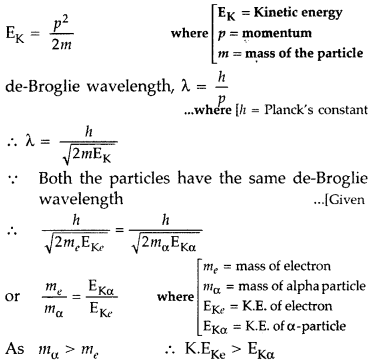
Question 2.
State the reason, why heavy water is generally used as a moderator in a nuclear reactor. (Delhi 2008)
Answer:
Neutrons produced during fission get slowed if they collide with a nucleus of the same mass. As ordinary water contains hydrogen atoms (of mass nearly that of neutrons), so it can be used as a moderator. But it absorbs neutrons at a fast rate via reaction :
![]()
Here d is deutron. To overcome this difficulty, heavy water is used as a moderator which has negligible cross-section for neutron absorption.
Question 3.
Name the absorbing material used to control the reaction rate of neutrons in a nuclear reactor. (Delhi 2008)
Answer:
Control rod or cadmium rod.
Question 4.
State two characteristic properties of nuclear force. (All India 2008)
Answer:
(i) Nuclear forces are the strongest force in nature.
(ii) They are saturated forces.
(iii) They are charge independent.
Question 5.
Two nuclei have mass numbers in the ratio 1: 2. What is the ratio of their nuclear densities? (Delhi 2008)
Answer:
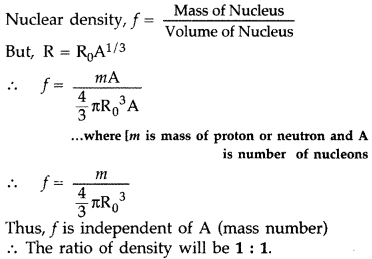
Question 6.
Two nuclei have mass number in the ratio 1 : 3. What is the ratio of their nuclear densities? (Delhi 2008)
Answer:
Since nuclear density is independent of the mass number, the ratio of nuclear densities will be 1:1.
Question 7.
Two nuclei have mass numbers in the ratio 2 : 5. What is the ratio of their nuclear densities? (Delhi 2008)
Answer:
Nuclear density is independent of mass number, so the ratio will be 1 : 1.
Question 8.
Two nuclei have mass numbers in the ratio 1: 8. What is the ratio of their nuclear radii? (All India 2008)
Answer:

Question 9.
Two nuclei have mass numbers in the ratio 8:125. What is the ratio of their nuclear radii? (All India 2008)
Answer:

Question 10.
Two nuclei have mass numbers in the ratio 27:125. What is the ratio of their nuclear radii?
Answer:

Question 11.
Write any two characteristic properties of nuclear force. (All India 2008)
Answer:
1. Nuclear forces are strongest forces in nature.
2. Nuclear forces are charge independent.
Question 12.
What is the relationship between decay constant and mean life of a radioactive nucleus? (Comptt. All India 2012)
Answer:
Relationship between decay constant and mean life of a radioactive nucleus is
![]()
Question 13.
Write the relationship between the size and the atomic mass number of a nucleus. (Comptt. All India 2012)
Answer:
Relationship between the size and the atomic mass number of a nucleus is

Question 14.
Define the activity of a given radioactive substance. Write its S.I. unit. (All India 2012)
Answer:
The activity of a radioactive substance is defined as the rate of disintegration of the substance. The SI unit for activity is becquerel (Bq).
Question 15.
How is the radius of a nucleus related to its mass number A? (Comptt. All India 2012)
Answer:
![]()
Question 16.
Why is it found experimentally difficult to detect neutrinos in nuclear P-decay? (All India 2012)
Answer:
It is found experimentally difficult to detect neutrinos in nuclear P-decay, because of two reasons :
(i) mass of neutrino is extremely small;
(ii) its charge is negligibly small.
Also, neutrinos interact very weakly with matter.
Question 17.
Name and define, the SI unit for the ‘activity’, of a given sample of radioactive nuclei. (Comptt. All India 2012)
Answer:
(i) becquerel is the SI unit of ‘activity’ of a nuclear sample.
(ii) One becquerel activity corresponds to ‘one decay/disintegration per second’.
Nuclei Class 12 Important Questions Short Answer Type (SA-I)
Question 18.
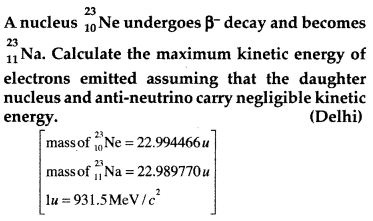
Answer:
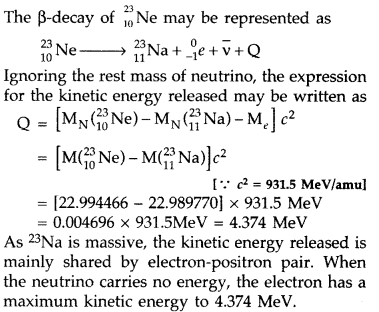
Question 19.
Calculate the energy released in MeV in the following nuclear reaction:
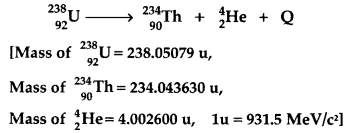 (All India 2012)
(All India 2012)
Answer:
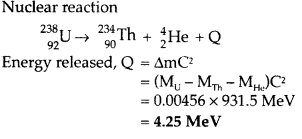
Question 20.
A radioactive nucleus ‘A’ undergoes a series of decays according to the following scheme:
![]()
The mass number and atomic number of A are 190 and 75 respectively. What are these numbers for A
4
? (Delhi 2016)
Answer:

So, the Mass number of A
4
→ 69
and Atomic number of A
4
→ 172
Question 21.
A radio active nucleus ‘A’ undergoes a series of decays according to the following scheme:
![]()
The mass number and atomic number of A are 180 and 72 respectively. What are these numbers for A
4
?
Answer:
The series can be shown as below:
![]()
So, the Mass number of A
4
is 182
and Atomic number of A
4
is 72
Question 22.
(a) The mass of a nucleus in its ground state is always less than the total mass of its constituents – neutrons and protons. Explain.
(b) Plot a graph showing the variation of potential energy of a pair of nucleons as a function of their separation. (All India 2016)
Answer:
(a) When nucleons approach each other to form a nucleus, they strongly attract each other. Their potential energy decreases and becomes negative. It is this potential energy which holds the nucleons together in the nucleus. The decrease in’ potential energy results in the decrease in the mass of the nucleons inside the nucleus.
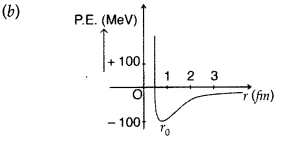
Question 23.
A heavy nucleus X of mass number 240 and binding energy per nucleon 7.6 MeV is split into two fragments Y and Z of mass numbers 110 and 130. The binding energy of nucleons in Y and Z is 8.5 MeV per nucleon. Calculate the energy Q released per fission in MeV. (Delhi 2016)
Answer:
![]()
∴ Gain in binding energy for nucleon = 8.5 – 7.6 = 0.9 MeV
Hence total gain in binding energy per nucleus fission = 240 × 0.9 = 216 MeV
Question 24.
Draw a plot of potential energy of a pair of nucleons as a function of their separation. Write two important conclusions which you can draw regarding the nature of nuclear forces. (All India 2016)
Answer:
Two important conclusions :
(i) Nuclear force between two nucleons falls rapidly to zero as their distance is more than a few femtometres. This explains constancy of the binding energy per nucleon for large-size nucleus.
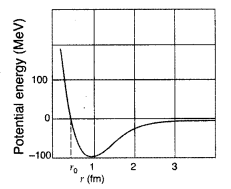
(ii) Graph explains that force is attractive for distances larger than 0.8 fin and repulsive for distances less than 0.8 fm.
Question 25.
Draw a plot of the binding energy per nucleon as a function of mass number for a large number of nuclei, 2 ≤ A ≤ 240. How do you explain the constancy of binding energy per nucleon in the range 30 < A < 170 using the property that nuclear force is short-ranged? (All India 2016)
Answer:
(a) The constancy of the binding energy in the range 30 < A < 170 is a consequence of the fact that the nuclear force is short ranged.
If a nucleon can have a maximum of p neighbours within the range of nuclear force, its binding energy would be proportional to p. Since most of the nucleons in a large nucleus reside inside it and not on the surface, the change in binding energy per nucleon would be small. The binding energy per nucleon is a constant and is approximately equal to pk. The property that a given nucleon influences only nucleons close to it, is referred to as saturation property of the nuclear force.
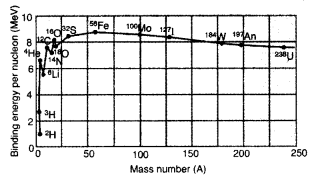
(b) Nuclear force is short-ranged for a sufficiently large nucleus. A nucleon is under the influence of only some of its neighbours, which come within the range of the nuclear force. If a nucleon can have maximum of P neighbours within the range of nuclear force, its binding energy would be proportional to ‘P’ Thus on increasing ‘A’ by adding nucleons binding energy will remain constant.
Question 26.
Using the curve for the binding energy per nucleon as a function of mass number A, state clearly how the release of energy in the processes of nuclear fission and nuclear fusion can be explained. (All India 2011)
Answer:
1. Nuclear fission : Binding energy per nucleon is smaller for heavier nuclei than the middle ones i.e. heavier nuclei are less stable. When a heavier nucleus splits into the lighter nuclei, the B.E./nucleon changes (increases) from about 7.6 MeV to 8.4 MeV. Greater binding energy of the product nuclei results in the liberation of energy. This is what happens in nuclear fission which is the basis of the atom bomb.
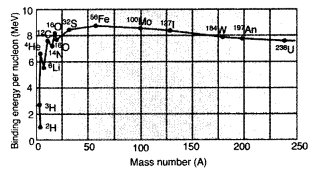
2. Nuclear fusion : The binding energy per nucleon is small for light nuclei, i.e., they are less stable. So when two light nuclei combine to form a heavier nucleus, the higher binding energy per nucleon of the latter results in the release of energy.
Question 27.
Complete the following nuclear reactions :
![]()
![]()
(Comptt. Delhi 2011)
Answer:

Question 28.
If both the number of protons and neutrons in a nuclear reaction is conserved, in what way is mass converted into energy (or vice verse)? Explain giving one example. (Comptt. Delhi 2011)
Answer:
Explanation for release of energy in a nuclear reaction : Since proton number and neutron number are conserved in a nuclear reaction, the total rest mass of neutrons and protons is the same on either side of the nuclear reaction.
But total binding energy of nuclei on the left side need not be the same as that on the right hand side. The difference in binding energy causes a release of energy in the reaction.
Examples :

Question 29.
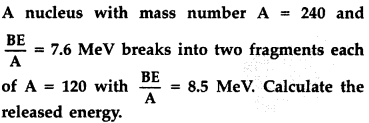
(Delhi 2016)
Answer:
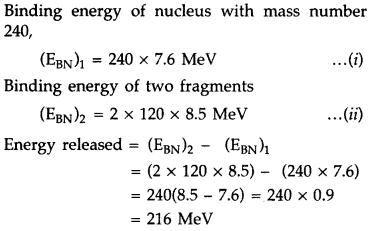
Question 30.
Calculate the energy in fusion reaction :

(Delhi 2016)
Answer:
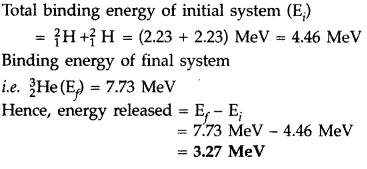
Question 31.
If both the number of protons and the number of neutrons are conserved in each nuclear reaction, in what way is mass converted into energy (or vice-versa) in a nuclear reaction? Explain. (Comptt. All India 2016)
Answer:
The number of protons and neutrons in a nuclear reaction are conserved but the total mass is not conserved.
The total mass of the free protons and neutrons is more than their total mass within the nucleus. The lost mass (= ∆m) known as ‘mass defect’, gets converted into energy as per the relation E = (∆m)c
2
(c is the velocity of light)
Question 32.
Write two characteristic features of nuclear force.
(b) Draw a plot of potential energy of a pair of nucleons as a function of their separation. (Comptt. All India 2017)
Answer:
(a) Nuclear forces. The strong forces of attraction which hold together the nucleons (neutrons and protons) in the tiny nucleus of an atom are called nuclear forces.
Important properties (characteristics):
1. Nuclear forces are independent of charge (These act between a pair of neutrons, between a pair of protons and between a proton and a neutron).
2. Nuclear forces are the strongest forces in nature.
3. Nuclear forces are very short range forces.
4. Nuclear forces are non-central forces.
5. Nuclear forces are dependent on spin.
(b) A plot of the potential energy between two nucleons as a function of distance is shown in the diagram.
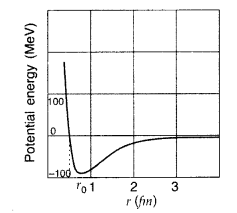
Important conclusions from the graph :
(i) The nuclear force is much stronger than the Coulomb force acting between charges or the gravitational forces between masses. The nuclear binding force has to dominate over the Coulomb repulsive force between protons inside the nucleus. This happens only because the nuclear force is much stronger than the coulomb force. The gravitational force is much weaker than even Coulomb force.
(ii) The nuclear force between two nucleons falls rapidly to zero as their distance is more than a few femtometers. This leads to saturation of forces in a medium or a large-sized nucleus, which is the reason for the constancy of the binding energy per nucleon.
(iii) The nuclear force between neutron- neutron, proton-neutron and proton-proton is approximately the same. The nuclear force does not depend on the electric charge.
Question 33.
Write the relation between half life and decay constant of a radioactive nucleus. (Comptt. All India 2017)
Answer:
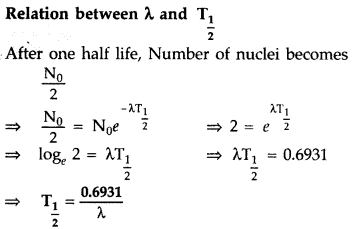
Question 34.
Two radioactive samples, X, Y have the same number of atoms at t = 0. Their half lives are 3h and 4h respectively. Compare the rates of disintegration of the two nuclei after 12 hours. (Comptt All India 2017)
Answer:
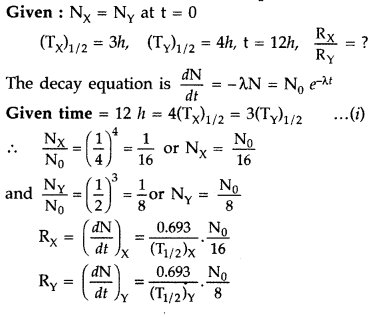

Question 35.
Distinguish between nuclear fission and fusion. Explain how the energy is released in both the processes. (Comptt. All India 2017)
Answer:
In nuclear fission a heavy nucleus breaks up into smaller nuclei accompanied by release of energy; whereas in nuclear fusion two light nuclei combine to form a heavier nucleus accompanied by release of energy.
In both the cases, some mass (= mass defect) gets converted into energy as per the relation :
![]()
Nuclei Class 12 Important Questions Short Answer Type SA-II
Question 36.
Draw a plot showing the variation of binding energy per nucleon versus the mass number (A). Explain with the help of this plot the release of energy in the processes of nuclear fission and fusion. (All India 2009)
Answer:
1. Nuclear fission : Binding energy per nucleon is smaller for heavier nuclei than the middle ones i.e. heavier nuclei are less stable. When a heavier nucleus splits into the lighter nuclei, the B.E./nucleon changes (increases) from about 7.6 MeV to 8.4 MeV. Greater binding energy of the product nuclei results in the liberation of energy. This is what happens in nuclear fission which is the basis of the atom bomb.
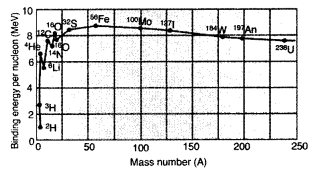
2. Nuclear fusion : The binding energy per nucleon is small for light nuclei, i.e., they are less stable. So when two light nuclei combine to form a heavier nucleus, the higher binding energy per nucleon of the latter results in the release of energy.
Question 37.
Define the activity of a radionuclide. Write its S.I. unit. Give a plot of the activity of a radioactive species versus time.
How long will a radioactive isotope, whose half life is T years, take for its activity to reduce to 1/8
th
of its initial value? (All India 2009)
Answer:
Activity: It is defined as the total decay rate of a sample of one or more radionuclide.
Its S.I. unit is bequerel
I bequerel = 1 decay per second
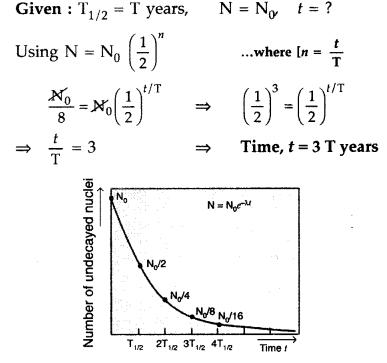
Question 38.
(i) Define ‘activity’ of a radioactive material and write its S.I. unit.
(ii) Plot a graph showing variation of activity of a given radioactive sample with time.
(iii) The sequence of stepwise decay of a radioactive nucleus is
![]()
If the atomic number and mass number of D
2
, are 71 and 176 respectively, what are their corresponding values for D?
Answer:
Activity: It is defined as the total decay rate of a sample of one or more radionuclide.
Its S.I. unit is bequerel
I bequerel = 1 decay per second


Question 39.
(a) Write symbolically the P“ decay process of \(\begin{array}{l}{32} \\ {15}\end{array}\).
(b) Derive an expression for the average life of a radionuclide. Give its relationship with the half-life. (All India 2009)
Answer:
![]()
(b) Suppose a radioactive sample contains N0 nuclei at time t = 0. After time this number reduces to N. Furthermore, suppose dN nuclei disintegrates in time t to t + dt. As dt is small so the life of each of the dN nuclei can be approximately taken equal to t
∴ Total life of dN nuclei = tdN
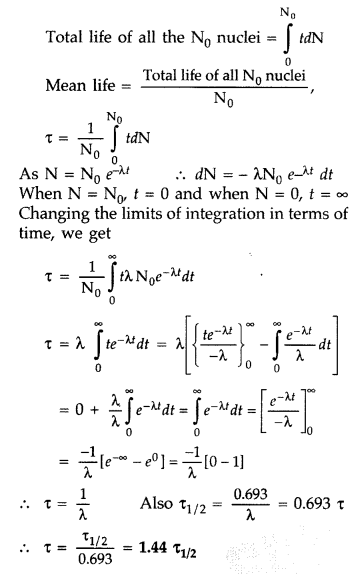
Question 40.
State the law of radioactive decay.
Plot a graph showing the number (N) of undecayed nuclei as a function of time (t) for a given radioactive sample having half life T
1/2
. Depict in the plot the number of undecayed nuclei at
(i) t = 3 T
1/2
and
(ii) t = 5
1/2
.(DeIhi 2009)
Answer:
The number of nuclei undergoing decay per unit time, at any instant is proportional to number of nuclei in the sample at that instant. The given figure shows a graph between the number of undecayed nuclei as a function of time.
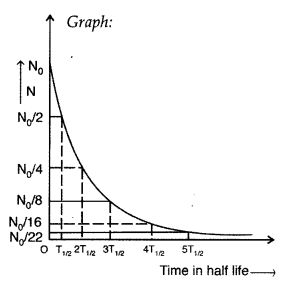
Question 41.
(i) What characteristic property of nuclear force explains the constancy of binding energy per nucleon (BE/A) in the range of mass number ‘A’ lying 30 < A < 170?
(ii) Show that the density of nucleus over a wide range of nuclei is constant- independent of mass number A. (Delhi 2009)
Answer:
(i) Saturation is the Short range nature of nuclear forces
(ii) Let A be the mass number and R be the radius of a nucleus
If m is the average mass of a nucleon, then
Mass of nucleus = mA
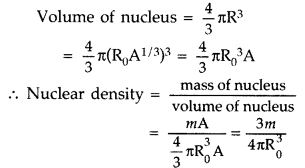
Clearly, nuclear density is independent of mass number A or the size of the nucleus.
Question 42.
Draw a plot of potential energy of a pair of nucleons as a function of their separations. Mark the regions where the nuclear force is
(i) attractive and
(ii) repulsive. Write any two characteristic features of nuclear forces.
Answer:
The graph indicates that the attractive force between the two nucleons is strongest at a separation r
0
= 1 fm. For a separation greater than the force is attractive and for separation less than r
0
, the force is strongly repulsive.
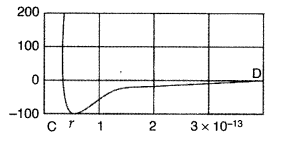
Two characteristic features of nuclear forces :
1. Strongest interaction
2. Short-range force
3. Charge independent character (any two)
Question 43.
Answer the following, giving reasons:
(i) Why is the binding energy per nucleon found to be constant for nuclei in the range of mass number (A) lying between 30 and 170?
(ii) When a heavy nucleus with mass number A = 240 breaks into two nuclei, A = 120, energy is released in’ the process.
(iii) In β-decay, the experimental detection of neutrinos (or antineutrinos) is found to be extremely difficult. (Comptt. All India 2011)
Answer:
(i) Nuclear forces are short ranged. For a particular nucleon inside a sufficiently large nucleus will be under the influence of some of its neighbours which come within the range of the nuclear force. The property that a given nucleon influences only nucleons close to it is also referred to as saturation property of the nuclear force.
(ii) The binding energy per nucleon of the parent nucleus is less than those of the two daughter nuclei. It is this increased binding energy that gets released in this process.
(iii) Neutrinos are chargeless and massless particles, whose interaction with other particles is almost negligible. Hence, they can pass through very large quantity of matter with-out getting detected.
Question 44.
(a) In a typical nuclear reaction, e.g.
![]()
although number of nucleons is conserved, yet energy is released. How? Explain.
(b) Show that nuclear density in a given nucleus is independent of mass number A. (Delhi 2011)
Answer:
(a) In all types of nuclear reactions, the law of conservation of number of nucleons is followed. But during the reaction, the mass of the final product is found to be slightly less than the sum of the masses of the reactant components. This difference in mass of a nucleus and its constituents is called mass defect. So, as per mass energy relation E = (∆M)c
2
, energy is released. In the given reaction the sum of the masses of two deutrons is more than the mass of helium and neutron. Energy equivalent of mass defect is released.
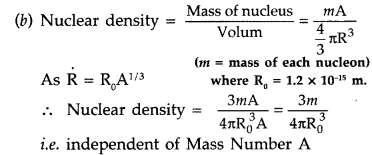
Question 45.
![]()
though the conserved on both sides of the reaction, yet the energy is released. How? Explain.
(b) Draw a plot of potential energy between a pair of nucleons as a function of their separation. Mark the regions where potential energy is
(i) positive and
(ii) negative. (Delhi 2011)
Answer:
(a) Since the total binding energy of nuclei on the left side of the reaction is not the same as the total binding energy of nucleus on the right hand side, this difference of binding energy appears as the energy released.
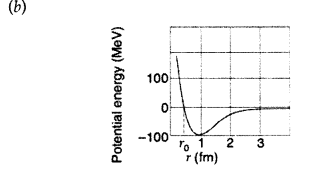
For separation (r) ≤ 0.8 fermi
Force is repulsive
For r > 0.8 fermi force will be attractive.
Question 46.
(a) The number of nuclei of a given radioactive sample at time t = 0 and t = T are N
0
and N
0
/n respectively. Obtain an expression for the half-life (T
1/2
) of the nucleus in terms of n and T.
(b) Write the basic nuclear process underlying β-decay of a given radioactive nucleus. (Comptt. Delhi 2013)
Answer:
(a) Decay constant. It is the reciprocal of the time interval in which the number of active nuclei in a radioactive sample reduces to 1/e times of its initial nuclei.
Half life period. It is the time during which half the total number of atoms in radioactive elements (N
0
) disintegrates. It is denoted by t
1/2
.
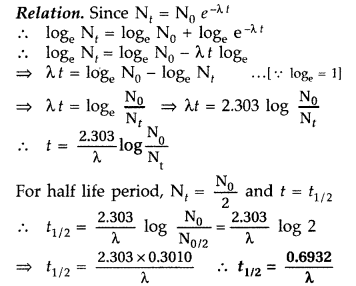
(b) β-decay. It is the phenomenon of emission of an electron from a radioactive nucleus. In Beta-minus decay, a neutron transforms into a proton within the nucleus. According to
![]()
The emission of β-particle from an atom will change it into a new atom whose atomic number is increased by one without changing its mass number.

Question 47.
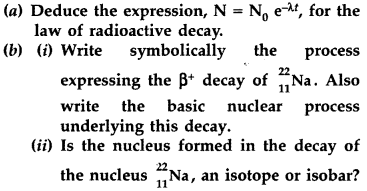
(Delhi 2014)
Answer:
(a) Radioactive decay law. It states that “the number of atoms disintegrated per second at any instant is directly proportional to the number of radioactive atoms actually present at that time.” Let N
0
be the total number of atoms present at time t = 0 (initially)
and N be the total number of atoms present at time t, then
According to radioactive decay law, the rate of disintegration at any time t is directly proportional to the number of atoms present at that time t.
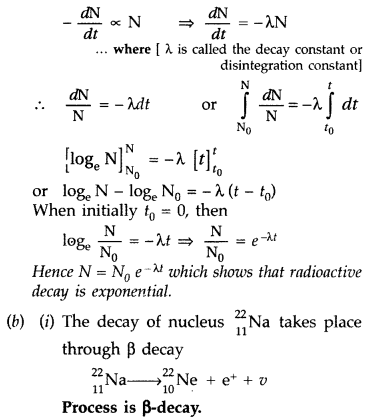
(ii) Since new nucleus has the same mass number, hence it would be an Isobar.
Question 48.
Write the relation for binding energy (BE) (in MeV) of a nucleus of \(_{Z}^{A} N\), atomic number (Z) and mass number (A) in terms of the masses of its constituents – neutrons and protons.
(b) Draw a plot of BE/A versus mass number A for 2 ≤ A ≤ 170. Use this graph to explain the release of energy in the process of nuclear fusion of two light nuclei. (Comptt. Delhi 2014)
Answer:
(a) Mass defect. The difference between the sum of the masses of neutrons and protons forming a nucleus and mass of the nucleons is called mass defect.
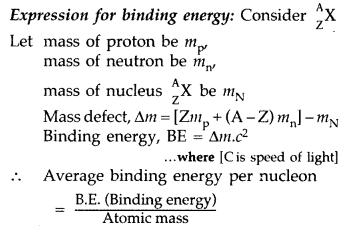
(b)
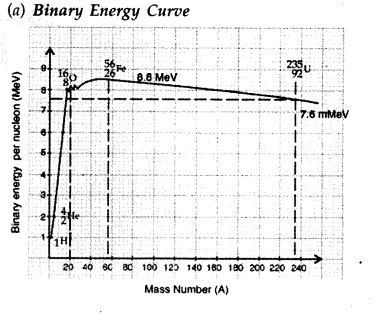
Conclusions :
(i) The force is attractive and sufficiently strong to produce a binding energy of a few MeV per nucleon.
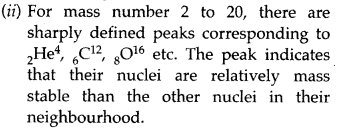
(b) (i) When we move from heavy nuclei region to middle region, we find that there will be a gain in overall binding energy and hence release of energy. This indicates that energy can be released when a heavy nucleus breaks into two roughly equal fragments/nuclear fission.
(ii) Similarly, when we move from lighter nuclei to heavier nuclei, we find that there will be gain in overall binding energy and hence release of energy. This indicates that energy can be released when two lighter
nuclei fuse together to form heavy nucleus/nuclear fusion.
(c) In Beta decay a neutron breaks into a proton, electron and neutrino as

Detection of neutrinos is difficult because they are chargeless and have either no or low mass.
Question 49.
(a) Define the term ‘activity of a sample of radioactive nucleus. Write its S.I. unit.

(Comptt. All India 2014)
Answer:
(a) The activity of a radioactive nucleus equals its decay rate (or number of nuclei decaying per unit time)
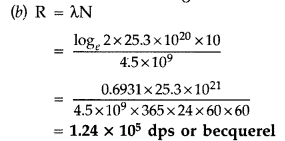
Question 50.
(i) Write the relation between ‘average life’ and ‘half-life’ of a radioactive nucleus.

(Comptt. All India 2014)
Answer:

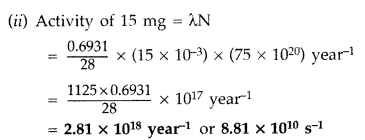
Question 51.
(i) Define the term ‘mass defect’ of a nucleus. How is it related with its binding energy?
(ii) Determine the Q-value of the following reaction:
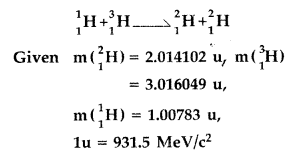
(Comptt. All India 2014)
Answer:
(i) (a) The mass defect of a nucleus equals the difference between the total mass of its constituents and the mass of the nucleus itself.
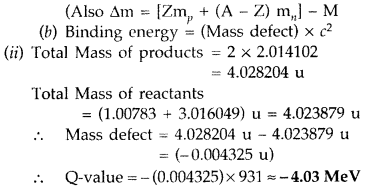
Question 52.
Distinguish between nuclear fission and fusion. Show how in both these processes energy is released.
Calculate the energy release in MeV in the deuterium-tritium fusion reaction :
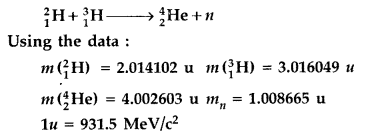
(Delhi 2015)
Answer:
(a) The breaking of heavy nucleus into smaller fragments is called nuclear fission; while the joining of lighter nuclei to form a heavy nucleus is called nuclear fusion.
(b) Binding energy per nucleon of the daugher nuclei, in both processess, is more than that of the parent nuclei. The difference in binding energy is released in the form of energy. In both processes some mass gets converted into energy.
(c) Energy released
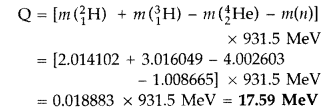
Question 53.
(a) Write three characteristic properties of nuclear force.
(b) Draw a plot of potential energy of a pair of nucleons as a function of their separation. Write two important conclusions that can be drawn from the graph. (All India 2015)
Answer:
(a) Nuclear forces. The strong forces of attraction which hold together the nucleons (neutrons and protons) in the tiny nucleus of an atom are called nuclear forces.
Important properties (characteristics):
1. Nuclear forces are independent of charge (These act between a pair of neutrons, between a pair of protons and between a proton and a neutron).
2. Nuclear forces are the strongest forces in nature.
3. Nuclear forces are very short range forces.
4. Nuclear forces are non-central forces.
5. Nuclear forces are dependent on spin.
(b) A plot of the potential energy between two nucleons as a function of distance is shown in the diagram.
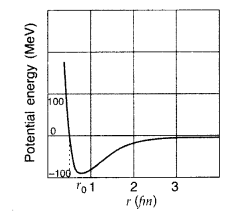
Important conclusions from the graph :
(i) The nuclear force is much stronger than the Coulomb force acting between charges or the gravitational forces between masses. The nuclear binding force has to dominate over the Coulomb repulsive force between protons inside the nucleus. This happens only because the nuclear force is much stronger than the coulomb force. The gravitational force is much weaker than even Coulomb force.
(ii) The nuclear force between two nucleons falls rapidly to zero as their distance is more than a few femtometers. This leads to saturation of forces in a medium or a large-sized nucleus, which is the reason for the constancy of the binding energy per nucleon.
(iii) The nuclear force between neutron- neutron, proton-neutron and proton-proton is approximately the same. The nuclear force does not depend on the electric charge.
Question 54.
Complete the following nuclear reactions :

(c) Why is it found experimentally difficult to detect neutrinos? (Comptt. All India 2017)
Answer:
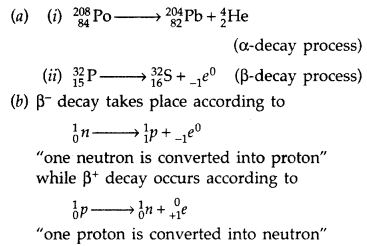
It is found experimentally difficult to detect neutrinos in nuclear P-decay, because of two reasons :
(i) mass of neutrino is extremely small;
(ii) its charge is negligibly small.
Also, neutrinos interact very weakly with matter.
Question 55.
(a) Write the basic nuclear process involved in the emission of β
+
in a symbolic form, by a radioactive nucleus.
(b) In the reactions given below :

Find the values of x, y, and z and a, b and c. (All India 2017)
Answer:
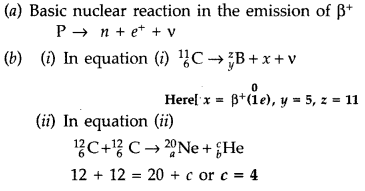

Question 56.
Obtain the relation \(\mathbf{N}=\mathbf{N}_{0} e^{-\lambda t}\) for a sample of radioactive material having decay constant λ, where N is the number of nuclei present at constant λ. Hence obtain the relation between decay constant λ and half life \(\mathbf{T}_{\frac{1}{2}}\) of the sample. (Comptt. Delhi 2017)
Answer:
(i)
(a) Radioactive decay law. It states that “the number of atoms disintegrated per second at any instant is directly proportional to the number of radioactive atoms actually present at that time.” Let N0 be the total number of atoms present at time t = 0 (initially)
and N be the total number of atoms present at time t, then
According to radioactive decay law, the rate of disintegration at any time t is directly proportional to the number of atoms present at that time t.
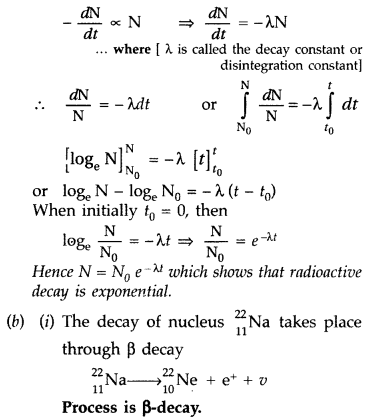
(ii) Relation between X and \(\mathbf{T}_{\frac{1}{2}}\)
After one half life, Number of nuclei becomes
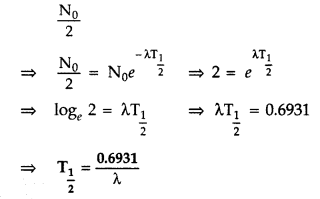
Question 57.
(i) A radioactive nucleus ‘A’ undergoes a series of decays as given below:
![]()
The mass number and atomic number of A
2
are 176 and 71 respectively.
Determine the mass and atomic numbers of A
4
and A.
![]()
(Delhi 2017)
Answer:
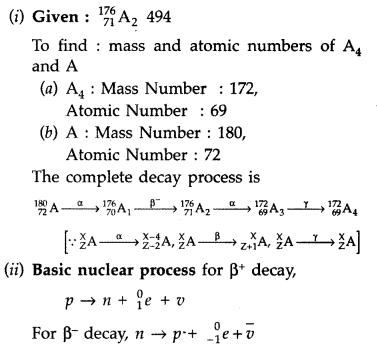
Question 58.
(a) Draw a graph showing the variation of binding energy per nucleon (BE/A) vs mass number A for the nuclei in 20 ≤ A ≤ 170.
(b) A nucleus of mass number 240 and having binding energy/nucleon 7.6 MeV splits into two fragments Y, Z of mass numbers 110 and 130 respectively. If the binding energy/ nucleon of Y, Z is equal to 8.5 MeV each, calculate the energy released in the nuclear reaction. (Comptt. All India 2017)
Answer:
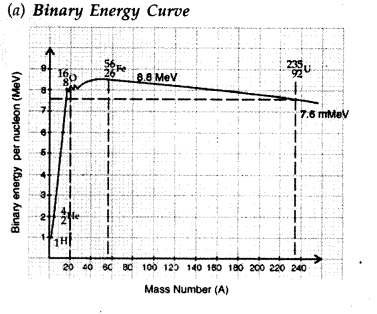
Conclusions :
(i) The force is attractive and sufficiently strong to produce a binding energy of a few MeV per nucleon.
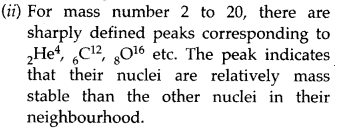
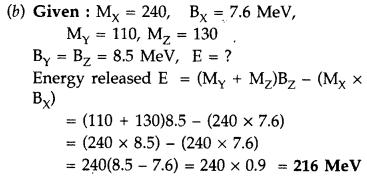
Nuclei Class 12 Important Questions Long Short Answer Type
Question 59.
(a) Define the term ‘activity’ of a given sample of radionuclide. Write the expression for the law of radioactive decay in terms of the activity of a given sample.
(b) A radioactive isotope has a half life of T years. How long will it take the activity to reduce to 3.125% of its original value?
(c) When a nucleus (X) undergoes β-decay, and transforms to the nucleus (Y), does the pair (X, Y) form isotopes, isobars or isotones? Justify your answer. (Comptt. Delhi 2012)
Answer:
(a) The activity of a radioactive source is measured by the rate of disintegration of the source. It is denoted by ‘A’
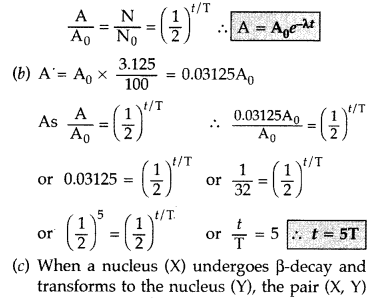
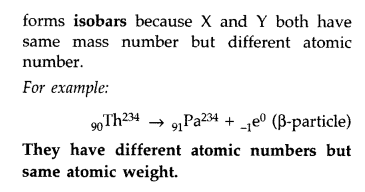
Question 60.
(a) Draw the plot of binding energy per nucleon (BE/A) as a function of mass number A. Write two important conclusions that can be drawn regarding the nature of nuclear force.
(b) Use this graph to explain the release of energy in both the processes of nuclear fusion and fission.
(c) Write the basic nuclear process of neutron undergoing β-decay. Why is the detection of neutrinos found very difficult?
Answer:
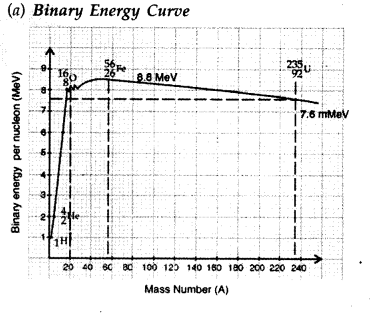
Conclusions :
(i) The force is attractive and sufficiently strong to produce a binding energy of a few MeV per nucleon.
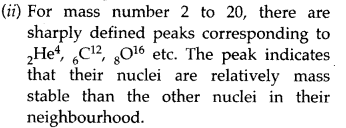
(b) (i) When we move from heavy nuclei region to middle region, we find that there will be a gain in overall binding energy and hence release of energy. This indicates that energy can be released when a heavy nucleus breaks into two roughly equal fragments/nuclear fission.
(ii) Similarly, when we move from lighter nuclei to heavier nuclei, we find that there will be gain in overall binding energy and hence release of energy. This indicates that energy can be released when two lighter
nuclei fuse together to form heavy nucleus/nuclear fusion.
(c) In Beta decay a neutron breaks into a proton, electron and neutrino as

Detection of neutrinos is difficult because they are chargeless and have either no or low mass.